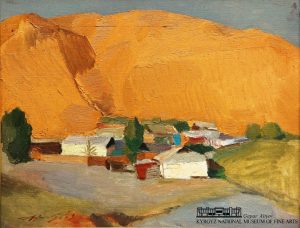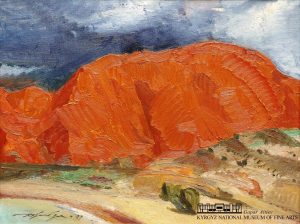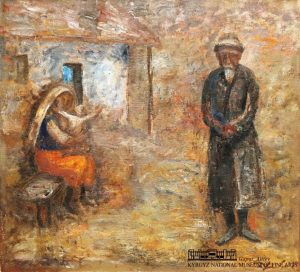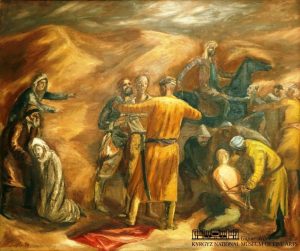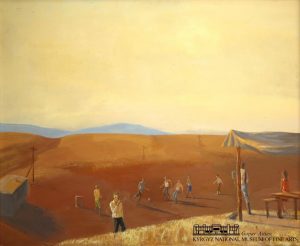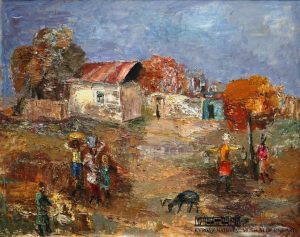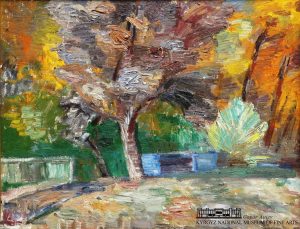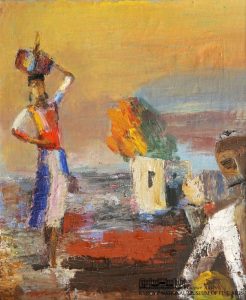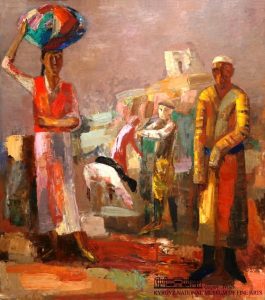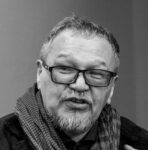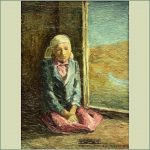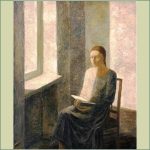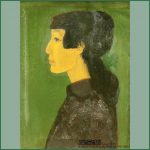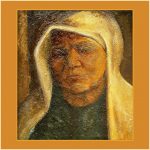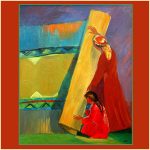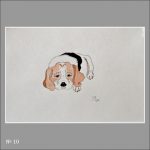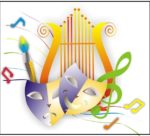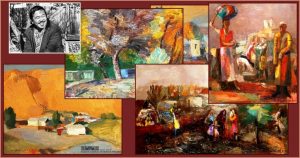
The review of the work of JAMBUL JUMABAYEV placed below continues to acquaint you with the paintings by Kyrgyz artists in the collection of the Museum of Fine Arts named after G. Aitiev through the eyes of art historian GAMAL BOKONBAYEV. Some of the works are presented on the museum’s website, the rest are in the collection, but are not presented on the museum’s website.
Jambul Jumabaev (1946-2005) – painter and drafter, book illustrator and production designer for feature and television films. His works are in the G. Aitiev State Fine arts museum, the Tretyakov Gallery, the State Museum of the East in Moscow, the museums of Saratov, Novosibirsk, Astrakhan, as well as in private collections in Japan, Germany, USA, Greece, Italy, etc.
The review covers 28 works. All of them are thematic, but conditionally one can divide them into genres. Four landscapes, 4 portraits, the remaining 20 works are thematic compositions.
We divided the review into two parts – 14 works each.
Landscape #2. Oil on canvas, 49.8×65, 1991
The author marked the picture number two! This is the serial number of the exercise and at the same time – a conceptual statement! In those days, it was fashionable to do so! The second attempt at a visual study of the sacred essence of the Kyrgyz landscape! That is how it is! The work could well be called “Yellow Mountain”; it dominates here, its shape, texture, color. We see only a flat fragment, but we feel something huge and even. A small village nestled under the slope of the mountain; it has its own life: one-story buildings, roofs, white walls, green trees, brown fences. There is an accent – blue gates! Next to, it is a huge yellow spot. Unbelievably beautiful! The main contrast of the composition is the contrast of one-color and multi-colored. A paradoxical observation – the edge of the gray sky above echoes the gray dirt road below; they both turned gray, but not from the clouds – from the sun, which shines too brightly … Yellow is not yet an abstraction. At the same time, it is not design. It is still painting. The artist realistically depicts reality based on natural impressions, but he does it like a philosopher and a poet. Therefore, the village is a kurak*, it is woven from various shreds of life. Moreover, yellow is the color of the sun reflected off the mountain. Reflection eats eyes! The sun turned all colors to ashes, but the colors invented by man could not! There is a lot of everything here, from impressionism to cubism, and at the same time, it is Kyrgyz, natural and human. Eternity froze, the beautiful stopped! Great artist, great talent, great soul… Inexplicable like nature! Nature can cover the village with a mountain, without explaining anything to anyone. Eternity is eternity, and landslides should be avoided.
*Kurak is an ancient Kyrgyz technique of patchwork and mosaic sewing, which is also inherent in many other peoples
Landscape #1. Oil on canvas, 49.8×65, 1991
The author decided to return to the open air! To direct natural impressions! To a realistic display of reality! He remained a poet. Designated the work as the first number! How is the exercise? How is the statement? Probably this and that. I could call the landscape “Red Mountain” it dominates here, its shape, texture, color. It was as if a monster lay down in the valley, huge, strong, naked and beautiful. The contrast of red ocher and lead, dark gray. Thunderclouds hung in transparent glazing; cold slopes peep here and there; a mountain of red clay is molded in dense layers. The third, not superfluous, dilutes the drama – the foothills. It diversifies the composition with a mixture of yellow and green shades, emphasizing the grandeur of the simplicity of the universe. A dirt road, trees and bushes explain the true scale of the creation of nature and the place of man in it … This is not an abstraction, not a far-fetched composition! The artist subtly captured the familiar mood. It happens like this: thunderclouds have gathered behind the mountain, it is raining and cold there, but here – while the warm, gentle sun is shining. Silence and grace. It happens in life too: a black streak is approaching, but the danger is still far away, but for now, we enjoy life and art! Let us have fun and eat! Trouble will come, and then we will worry. Maybe it will pass. Side? … Ahead of the 90s, fateful, not simple, thunderous! The collapse of the USSR, the era of change, and such a wise, picturesque and vital parting word is not superfluous at all.
Difficult years. Oil on canvas, 99×100, 1985
On the right is an aksakal, on the left is a grandmother sitting on a bench, holding a child on her lap. A part of the house is visible, a veranda, a door, a window. Men are at war, women are on the labor front. Old men in alarm: will the men return? In addition, how are the women? There is a light anxiety, and this is a dark one. A very sad grandfather, a sad grandmother, the child threw up his hands, but not joyfully – he is naughty. The background is conditional; there is no greenery, no blue sky. There is only invoice. Form convergence occurs the main features of the works of Jambul Jumabaev and Satar Aitiev. However, at Jambul everything is done more beautifully. Too beautiful! There are not enough complex emotions, paradoxical associations. In addition, the skill of the artist does not help. Why the artist highlighted the door so strongly in blue? As if this is an exit to another space… Most likely, this is a formal accent, made according to the composition, and this is its only meaning. In the mid-1980s, the contradictions of Soviet modernism intensified. It remains plot and loses relevance. There were no more topics that could be safely discussed in bird language. Works about nothing – this is the general result, which will come to the fine arts of Soviet Kyrgyzstan. The easel painting of Kyrgyzstan still suffers from this disease … Here you can try to update the plot! Find out: whose child is this? Where is the mother, was there a father? However, you do not have to do this. Soon “perestroika and glasnost” will begin, everything will be questioned, and there will be plenty of anti-artistic blackmail.
Spring of 1945. Oil on canvas, 89×99, 1985
Two people are sitting on the ground: a woman and a man. A one-legged soldier, a crutch nearby, woman is breastfeeding her baby. Between them is a tablecloth with a meager meal. To their left is a girl, turned and looks into the distance, holding one hand behind her head, in the other hand – a handkerchief. Gray day, gray-earthy coloring, figures and background are generalized. The military tunic stands out in color, the woman’s active red dress; the girl’s blue sleeveless jacket languishes. A soldier in the war became disabled, returned and a child was born in his rear, and now they, with the whole family, are waiting for the long-awaited Victory. However, on the faces of grief and sympathy. Because the girl is waiting for someone who will never return. In addition, in the spring, hope is reborn! … Alternatively, maybe the girl is pregnant! How early widowed Aliman, Tolgonai’s daughter-in-law, from Chyngyz Aitmatov’s story “Mother’s Field”. She did not have a handkerchief in her hand; the woman tore a white handkerchief from her head! Such an interpretation expands the semantic space of the picture! It makes the feelings of the characters more voluminous, more tragic and … more humane … In 1985, the 40th anniversary of the Victory in the Great Patriotic War was celebrated. There were many thematic exhibitions. During the exhibitions, the museum bought works and it is very good that I bought this particular painting, one of the most difficult to interpret, ambiguous, fantastically deep!
Reprisal against activists. Oil on canvas, 149×180, 1984
Enemies of the Soviet government broke into the homes of sleeping activists, fighters for revolutionary changes, at night. Caught by surprise, three are tied with ropes and taken away for reprisal. The old men were pushed to the left side, they scream in horror. What can they do against the young? In addition, there are much more thugs; eight members of the gang fit into the composition. A red flag is trampled on the ground. Soon the earth will be stained with blood, there is a saber, but still in a sheath. The leader of the Basmachi* on a black horse. There are no other details; the expression of the figures speaks for everything. The background is a mountain valley. Clay ocher and cold black create an atmosphere of horror … Now we have a different attitude to such topics. In addition, the definition of “basmach” is perceived differently. Then, a talented Soviet artist wanted to testify to his political reliability and earn some money. In 1984, they celebrated the anniversary – 60 years of the Communist Party of Soviet Kyrgyzstan. In addition, most likely, there were a great many thematic exhibitions. During the exhibitions, the museum had to buy ideologically consistent works… It can be seen that the stage captivated the author with its drama, the movement of the masses, and flashes of light. In those days, the theatricality of revolutionary romance and stilted characters from the era of the formation of Soviet power looked appropriate: turbaned Basmachi – scary, bearded, and activists – young, bright. The optimistic tragedy is that the enemies temporarily gain the upper hand by using dastardly tricks. All the art of the USSR served the purpose of educating the youth for a correct communist worldview. I remember the film “Bow to the Fire” (1971, directed by Tolomush Okeyev); the final scene from this film is terrible and bloody. How can this issue be resolved now? Show how the Bolsheviks deal with the Basmachi? Black Bolsheviks and light Basmachi? Do not know. Moreover, nobody knows. On the one hand, we fell in love with Soviet stereotypes, for example, through the film The Seventh Bullet (1972), in which Suimenkul Chokmorov played the role of a fighter against the Basmachism superbly. On the other hand, violence is always bad.
*Basmachi – According to Soviet historiography, the Basmachi is an armed counter-revolutionary nationalist movement in Central Asia in 1917-1926.
Rural motive. Oil on canvas, 90×150, 1984
They work with the whole collective farm! Brigade! Family! In the center, a woman with a baby sitting on a mat, happy and smiling! Nearby, girlfriends string tobacco leaves on twine and manage to gossip like a neighbor. On the left side, a girl in a skullcap carries ready-made “garlands”, and on the right, a man and a woman hang tobacco for drying. Most likely, they will leave it on the street, and at night, they will put it in a barn. A barn with an open gate is visible in the distance, on a hillock. Mostly women work, they are helped by the only man in the team, wearing a kalpak* and boots. Gray cloudy day. Golden ocher dominates, vet tobacco and earth color. Other shades adjusted to the overall color, turned gray. The form obeys the movement of the brush, and the movement of the brush obeys the movement of the soul of the artist. Moreover, he is temperamental, likes to change the rhythm and pace. Fill your fantasies with life observations. The artist saw the Tobacco Madonna in the South, an angel in a skullcap with garland wings, the peasants Millet and Van Gogh working late by hand. He did not follow the socialist realist dogmas. The form turned out to be brutal, like dirty earth, like hard truth! Accused of sketchiness, incompleteness, and approximations. There is such a thing. What figure rises behind the Madonna? Do not understand. Too abstract! However, abstraction looks true in an era when everything becomes a lie.
*Kalpak – Kyrgyz traditional men’s hat made from felt
Southern motive. Oil on canvas, 89.5х99.7, 1984
A young woman goes to work in the morning, for example, to trade in the market. One hand supports the burden on the head; the other is a tray of provisions tied with a tablecloth. In a red dress, in a blue sleeveless jacket, in a scarf of the same color. She looks back at the wrapped cradle, an older woman rocking it. A woman goes to work – a grandmother with a small child remains at home. Probably so. On the left is a tree trunk and part of the crown. Houses are crowded in the distance – this is a southern city. The artist started with a transparent underpainting in ocher and black, and then added color. This is what the old masters did, but in modernism, the techniques are accentuated. The color is located not according to the form and not according to the meaning – according to the composition. Moreover, the form is arbitrarily divided into parts by color. That is more interesting! It is a game! Yellow dominates, blue and red echo. Often they exist on their own, as independent elements of modern design. This is a southern motif color design! When did the word motive originate? It denoted something fleeting, elusive, and moody. Without any ideology. Nevertheless, the motive is something settled, and here is an experiment. Its modern south and a bit obscure. In addition, the artist is not embarrassed that the figure on the right looks like an Armenian artisan, judging by the dressing gown, trousers and headdress. The buildings of the southern city resemble the architecture of the Mediterranean. He does not care about these inconsistencies; he sees a new form in the inconsistencies. He is a citizen of the world and borrowing no longer seems like that. After all, in the end, everything should become common! Art should be without boundaries and conventions, when talent understands talent and together they serve the people, improving their tastes, making them versatile and deeper. Talents give the ability to perceive paradoxes! Moreover, through this to understand the beauty! On this path, fantastic spiritual discoveries await all of us! This was the main feature of Kyrgyz modernism! The main thing is optimism! Then a plot with a riddle, and at the end – a paradoxical color in a paradoxical form … And now we will call it eclecticism*, because there is no global community of talented artists. In addition, it is not expected.
Evening. Canvas, mixed media, 90×119, 1983
Who will now argue with the fact that Dzhambul Dzhumabaev is the first postmodernist in the visual arts of Kyrgyzstan? An artist can work in different styles at the same time and equally well! Playing … The guys after work play football. Most likely virgins. Or builders? The assembly team is pulling the power line. Cannot be more precise. Near the trailer, a canopy was made – a place for eating, relaxing and holding meetings. There are no other “talking” objects. They play three on three. Two do not play; they are more interested in a girl, probably a cook. She is resting, which means she has already had dinner. The end of a long summer day, the sun is setting. The picturesque space is formed by large masses. A huge sky, golden, clear, rich and oppressive. Independent and nothing else he needs! Illuminated surfaces – light ocher; own shadows – red; long, falling shadows – brown and cold. In addition, the figures are recognizable! Typical, high quality! They were developed by many generations of Russian-Soviet artists. Therefore, it worked out well. On the one hand, it testifies to skill. On the other hand, it is about compilability. In the Soviet Union, a quick change of manner was justified by several good reasons: firstly, by order, secondly, creative searches; and, thirdly, the theme of the forthcoming exhibition. For example, “Komsomol – virgin land!” Perhaps this is a sketch for a movie of the same name. In addition, the style was dictated by the style of the script. This is now considered a more complex issue. The master understands that one style (manner, handwriting) has its limitations, and for another topic, he tries another style (manner, handwriting). The artist has the right to experiment, the right to moral and financial support! Support was: the work was bought by the museum. However, the postmodern experiment, it is up to something! He is not on his own! He is from the understanding that everything is moving somewhere with monstrous speed and you need to catch up. Where to run? Unclear! It is impossible to develop further the form, and the content is impossible to develop! Moreover, a manner appears which will later be called postmodernism. If necessary, the author can make someone else’s style his own. Is it necessary? It looks like a joke of a very smart and talented artist who does not know what to do and starts the game! He took the Russian theme and did not suffer with the name.
Autumn in the south. Oil on canvas, no, 1983
We see the earth from above, and people from the usual level. Reminds me of a sketch for a theater or a movie. On the back, the walls of the house, buildings, fences lined up in a zigzag pattern. They hide from us rural courtyards with yellowed leaves on the trees. Mostly women on stage. Three march in formation (probably going to the market). Adults carry bundles on their heads: a woman and a teenager in blue jeans, we will call him Romeo. Next to a girl. Another well-dressed woman walks with a yoke. Blocks Juliet in purple, who froze near the tree and hides behind the trunk. The ocher ball of the crown of an orphan tree is the center of the common space. There are rams on the ground and the only man grazes with them… All other characters are hidden for the time being behind white walls. An exposition of a drama in which there will be no action. What remains is a picture that is by no means a good one. The conflict is not created by the plot, but by color and form. Three is unity, sameness, order and ritual. Elegant, yellow-red, triangular, overly active, she is in contrast with three regular ones. A black figure in the doorway. In addition, a talkative black opening on blue. Focus in a single window. All elements together draw a right arrow. What for? Sometimes it seems that the black in the middle is the real center. However, what can a grazing sheep tell us? Yes! It is not the plot that is important here – the emotions that … abstraction evokes are important! Nevertheless, before us is not a pure abstraction. Figures and characters are recognized, and they are silent about many things…! This is the South! Passive and furious, familiar and mysterious, friendly and indifferent.
Autumn in Arslan Baba. Oil on canvas, 29.7×64.4, 1981-1982
In the center is a walnut tree, the trunks are textured intertwined, the small leaves have turned gray and fallen off. The alley winds through the trees. Buildings with flat roofs lined the alley. Further, behind a hillock, green grass and small bushes are visible. The tops of the trees have already turned yellow. Most likely, this is on the territory of a boarding house in a walnut grove. Thick crowns block the sky, but cold uniform illumination penetrates from it. One of the few works by the author, made from nature. Done quickly, in some places the canvas is visible … The alley turns and it is clear that it goes along the top of the hill and has become a straight line. The bottom of the buildings, the ground on which they stand are not visible. Such an angle is considered to be losing, in educational work, among photographers, cameramen. In addition, the master is not afraid; he accepts the challenge and makes philosophy out of loss. Very often, the creations of human hands do not fit into nature, but these strange objects, straight lines and rectangles, do! It is no longer a building or an alley. These are geometric primitives, as in the metaphysical painting of Giorgio de Chirico. Only here everything is done in an intentionally casual way and the hints are thinner … In the midst of natural chaos, two trees form an arch over the road. This pathetic movement is supported by a decorative bush with branches directed upwards. In addition, two parallelepipeds divert the viewer’s attention to the side; do not let them catch on to understandable banalities. They seem to whisper: “Nature is not only trees! We are nature too! We contain light and shadow, color and form. We are simpler and clearer. The future is ours!”
Gray day. Oil on canvas, 69.5×90, 1981
A house on a hillock looks out through a dark window, an incomprehensible wall is attached to it, and next to it is a washed-out haystack. A white horse grazes on a dark brown square of a plowed garden. Warm earthy tones dominate, among which the steel-gray roof appears blue. The mess of colors beautifully writes out the mess of autumn mud. Yard surrounded by a hedge of shrubs, brushwood and poles. Thickets of reeds descend down to the river. Poplars and a hill in the distance. There is a white cloud in the gray sky. The view is similar to the suburbs of the capital, this is not a southern landscape, but the author does not have just landscapes. A white cloud, like a white square – a paradoxical accent, white on light gray. Something magical comes from it. White, dark brown, yellow are fantastic, they are not strangers, and they are from here, from this area. However, dark brown is a failure into the abyss; yellow – golden, like an alien’s armor; the upper corner outlines a mysterious dirty gray. It does not mean anything; it is dictated by the ideal composition. A lonely white cloud, large, beautiful, sad, stands over a horse, a house, a garden, hills. Beautiful, aloof, suffers and pities all of us (there is a similar excerpt from Yuri Kazakov’s story “There is a dog running” in 1961) … This feature of the Kyrgyz landscape was picked up by the Kyrgyz Art Nouveau. Correct field observations always lead to fantasy, and not only in the sky. In addition, if there is no science fiction, you get a set of educational stamps. Moreover, if only abstraction, it turns out to be an educational exercise in composition. 70-80 is the most powerful period in the philosophical landscape painting of Kyrgyzstan.
Evening. Oil on canvas, 60×60, 1981
A variation on the theme of the painting “Remembrance”, the general composition with the main characters is repeated. Do not understand what work was done before. Alternatively, maybe it does not matter, they appeared at the same time, and the artist in one work tried to continue what did not work out in another. Moreover, the museum bought both works! … Here the author tries to be freer, more beautiful, and more playful. The girl is thin, slender, arched in a tense arc! He holds a multi-colored knot on his head that looks like an apple! The image of youth is overly embellished and a little excited. A man in a skullcap intrudes from the side; he has a frighteningly black mustache, wide eyebrows, like Barmaley’s. He wears a shirt, is somewhat caricatured, and holds a melon under his arm. Alternatively, a kitty? A bundle that looks like an apple, a knapsack that looks like a melon … everything looks like something … Still, a melon, Barmaley wants to treat the girl. The sun is setting, the sky is orange. Burning reflections on everything. House with a flat roof, next to a tree. Blood red, fierce orange, poisonous green, dazzling white. Why did the author call the work “Evening”? This quote? Does not look like it. The author doubts his right to quote, is somewhere between modernism and postmodernism… Asel runs with Ilyas, taking his simple belongings? No. Ilyas is definitely not like that. Alternatively, maybe a party member wants to steal a Komsomol member. The author does not need such associations. He wants to get rid of the images that torment him… imagination is not the subconscious; it was not in Soviet culture (not even now). Beautiful colors, exquisite spots, singing lines, graceful rhythm, subtle coloring, successful composition, textured texture! – Please! Then you do not need to … There remains a feeling of understatement. The author jokes mysteriously and comes up with an unexpected formula: a banal evil is always hidden behind aesthetic painting.
Memory. Oil on canvas, 140×125, 1981
To the right is a man in a quilted robe tied with a blue handkerchief. Chapan without patterns, but golden! On the left, a woman in a crimson sleeveless jacket and with a burden on her head is a colorful bale sewn from rags. In the middle, the teenager leaned his hands on a ketmen* or on a shepherd’s crook. Two rams, white and black, graze nearby. Behind the boy in the distance, a woman in purple, apparently not young, crouched. In addition, even further away, an ancient mazar** rises on a hill. The environment is indicated by large volumes, and they emphasize the main thing – the triangle shapes. Could it be symbols? Youth (there are two of them), then youth, and even further – old age. It can be a family: father, mother and son. Alternatively, older brother and neighbor, or sister and neighbor. In any case, an adult woman and an adult man, and between them a teenager whose sympathies are on the side of the woman, she is brighter and more elegant. The man is a rival, he has long limp sleeves, and he is a dude in a golden chapan. His charm is in adulthood, in a beard, in a languid look, in black boots. Moreover, the teenager tries to imitate him in everything, in clothes, in manners, and looks defiantly. This is not good for him, the memory of adult’s remains. They are incomprehensible, complete opposites, a beauty and a slacker, and maybe a marijuana lover, but they are drawn to each other along the brown path and cannot be stopped.
*ketmen – it is a heavy hoe or hoe weighing almost a kilogram, in which its kinetic energy allows you to easily and quickly loosen the top layer of any soil.
**Mazar – mausoleum
Autumn. Oil on canvas, 88.5×149.5, 1980
Autumn, the outskirts of the village, houses, outbuildings, trees. Women are waiting for a scheduled bus. They are waiting near the road, which is not visible; it passes in front of the picture, where the viewer is. The eldest, middle and young are standing next to them with a child, a girl clung to them. To the side, a lone figure holds a burden on his head. Together they are close, and the one that does not join them is just a fellow villager. Therefore, the village is not small. Dark brown earth, yellowed trees, ocher and shades. In addition, bright color inserts. Coloristic unity, which consists of several layers. The bottom layer is transparent, liquid paints spread in subtle shades. The other layer is denser; these are mixtures, simple and complex, rubbed with a brush on a palette. Another layer is applied with a palette knife – these are open colors, such as they are in nature. In addition, the result is the technology of an incredibly complex pictorial score of the South! Not harmony, for one-dimensional – cacophony. Moreover, if you respond, you become a co-author of the most fruitful period in the work of the master. The composition does not obey the rules and the lighting is arbitrary, like an endless sky. You perceive the meaning according to the laws that the master created. This is the plastic metaphysics of the South. The goal is the same as that of the masters of realism. However, the author does not want to accumulate the image bit by bit. He conjures directly on the canvas, furiously, unconsciously, obeying only his artistic instinct. He is as free as the environment allows him to be. Moreover, the situation in the 80s was fantastically favorable!
Telegram-channel in Kyrgyz & Russian:
Санжарбек Данияровдун коомдук фонду
Фонд Санжарбека Даниярова
Subscribe if interested




